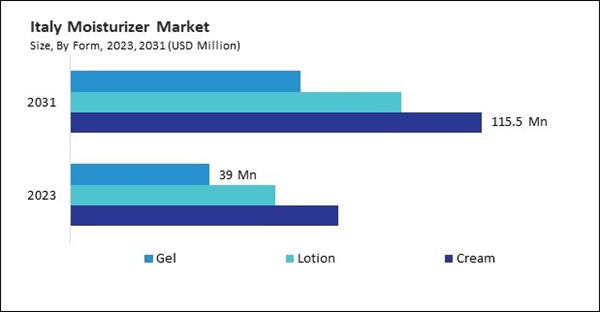Cream moisturizers are especially valued for their rich and thick consistency, which is effective in treating dry, sensitive, and mature skin. They are formulated with potent ingredients like hyaluronic acid, ceramides, and natural oils that not only hydrate but also repair and protect the skin's barrier. Thus, the Germany market would utilize25.78 million units (50 ML) of moisturizers by 2031.
The Germany market dominated the Europe Moisturizer Market by Country in 2023, and would continue to be a dominant market till 2031; thereby, achieving a market value of $929.6 Million by 2031. The UK market is exhibiting a CAGR of 3.5% during (2024 - 2031). Additionally, The France market would experience a CAGR of 5.1% during (2024 - 2031).
The influence of cultural shifts on the market cannot be overstated. Beauty standards and skincare routines vary significantly across different regions, and brands must adapt to these differences to succeed.
Additionally, moisturizer sales have been significantly influenced by the worldwide demographic transition to an aging population. As people age, their skin changes, making it more prone to dryness, wrinkles, and fine lines.
In Europe, beauty influencers like Lisa Eldridge and Caroline Hirons have a dedicated following that trusts their expertise in skincare. Their reviews and recommendations are highly valued, and when they highlight a particular moisturizer, it often results in increased sales and visibility for the product across European markets. Germany exhibits a growing demand for it, fueled by factors such as a strong emphasis on skincare and beauty, particularly among women.
Based on Type, the market is segmented into Face Moisturizer, and Body Moisturizer. Based on Form, the market is segmented into Cream, Lotion, and Gel. Based on End-user, the market is segmented into Women, Men, and Infant & Kids. Based on countries, the market is segmented into Germany, UK, France, Russia, Spain, Italy, and Rest of Europe.
List of Key Companies Profiled
- L'Oreal S.A.
- Unilever PLC
- The Procter & Gamble Company
- Johnson & Johnson
- Kao Corporation
- The Estee Lauder Companies, Inc.
- Shiseido Company Limited
- Beiersdorf AG
- Henkel AG & Company, KGaA
- Coty, Inc.
Market Report Segmentation
By Type (Volume, Thousand Units, USD Billion, 2020-2031)
- Face Moisturizer
- Body Moisturizer
By Form (Volume, Thousand Units, USD Billion, 2020-2031)
- Cream
- Lotion
- Gel
By End-user (Volume, Thousand Units, USD Billion, 2020-2031)
- Women
- Men
- Infant & Kids
By Country (Volume, Thousand Units, USD Billion, 2020-2031)
- Germany
- UK
- France
- Russia
- Spain
- Italy
- Rest of Europe
Table of Contents
Companies Mentioned
- L'Oreal S.A.
- Unilever PLC
- The Procter & Gamble Company
- Johnson & Johnson
- Kao Corporation
- The Estee Lauder Companies, Inc.
- Shiseido Company Limited
- Beiersdorf AG
- Henkel AG & Company, KGaA
- Coty, Inc.
Methodology

LOADING...









